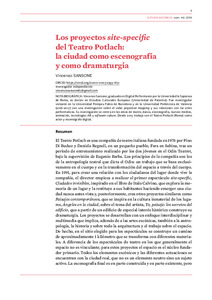The Site-Specific Projects of Teatro Potlach: The City as Set Design and Dramaturgy
Metadata
Show full item record
Estudis escènics: quaderns de l'Institut del Teatre. 2019, Núm. 44
Document typeArticle
Abstract
<p>Teatro Potlach is an Italian theatre company founded in 1976 by Pino Di Buduo and Daniela Regnoli in a little village, Fara In Sabina, after a period of training by the two young people at Odin Teatret, under the supervision of Eugenio Barba. The principles of the company are those of the theatre anthropology followed by Odin, the work exclusively based on the body and the transformation of the space through the body. In 1991, to create a relationship with the citizens of the place where the company lives, the director begins to perform the first site-specific performance, <em>Invisible Cities</em>, inspired by Italo Calvino’s book, which explores the memory of a place and gives it back to its inhabitants, letting a never seen before city appear. Subsequently he creates other similar projects like <em>Contemporary Landscapes</em>, inspired by the intangible culture of the places; <em>Angels over the City</em>, about the theme of the artist and <em>I Landscape – The Secrets of the Building</em>, which creates its dramaturgy based on a historical value building. The projects are developed with an interdisciplinary and multimedia approach that involves, in addition to the performing arts, anthropology, history and above all architecture and the work on a space. Indeed, on the place chosen for the performance, the company builds a path of about 1 kilometer that is transformed by means of different elements. Unlike theatre shows where the space is generally not binding, for these projects the space is the primary founding core. All the stage elements and the performances are linked to the real city, which is not a neutral element but an active subject. The final set design is partly built and partly real, but the built one depends on the real one that determines it. The city is not only set design but also dramaturgy because it is staged and tells itself. For this reason we can speak about “dramaturgy of space”, referring to dramaturgy, not only to the written text but also all the elements that create the whole performance. The final goal is to put citizens in contact with the culture and memory of the place where they live, which are the dramaturgical roots of these projects so that they are not forgotten and they are transmitted to the new generations.</p> <p>El Teatro Potlach es una compañía de teatro italiana fundada en 1976 por Pino Di Buduo y Daniela Regnoli, en un pequeño pueblo, Fara en Sabina, tras un período de entrenamiento realizado por los dos jóvenes en el Odin Teatret, bajo la supervisión de Eugenio Barba. Los principios de la compañía son los de la antropología teatral que dicta el Odin: un trabajo que se basa exclusivamente en el cuerpo y en la transformación del espacio a través del cuerpo. En 1991, para crear una relación con los ciudadanos del lugar donde vive la compañía, el director empieza a realizar el primer espectáculo de sitio específico, <em>Ciudades invisibles,</em> inspirado en el libro de Italo Calvino, que explora la memoria de un lugar y la restituye a sus habitantes haciendo emerger una ciudad nunca antes vista y, posteriormente, crea otros proyectos similares como <em>Paisajes contemporáneos</em>, que se inspira en la cultura inmaterial de los lugares, <em>Ángeles en la ciudad</em>, sobre el tema del artista, <em>Yo, paisaje: los secretos del edificio</em>, que a partir de un edificio de especial interés histórico construye su dramaturgia. Los proyectos se desarrollan con un enfoque interdisciplinar y multimedia que implica, además de a las artes escénicas, también a la antropología, la historia y sobre todo la arquitectura y el trabajo sobre el espacio. De hecho, en el sitio elegido para los espectáculos se construye un camino de aproximadamente 1 kilómetro que se transforma con diferentes materiales. A diferencia de los espectáculos de teatro en los que generalmente el espacio no es vinculante, para estos proyectos el espacio es el núcleo fundador primario. Todos los elementos escénicos y las diferentes actuaciones se encuentran con la ciudad real, que no es un elemento neutro sino un sujeto activo. La escenografía final es en parte construida y en parte existente, pero la construida depende de la existente, que la determina. La ciudad no es solo escenografía sino también dramaturgia porque se pone en escena y se cuenta a sí misma. Por esta razón se puede hablar de «dramaturgia del espacio» refiriéndose a dramaturgia, no solo al texto escrito, sino también al conjunto de elementos que componen toda la <em>performance</em>. El objetivo final es poner en contacto los ciudadanos con la cultura y memoria del lugar donde viven, que son las raíces dramatúrgicas de estos proyectos para que no se olviden y se transmitan a las nuevas generaciones.</p>
Access conditionsOpen Access
ISSN2385-362X
,
0212-3819
Collections
- 2019: Núm.: 44 [22]


